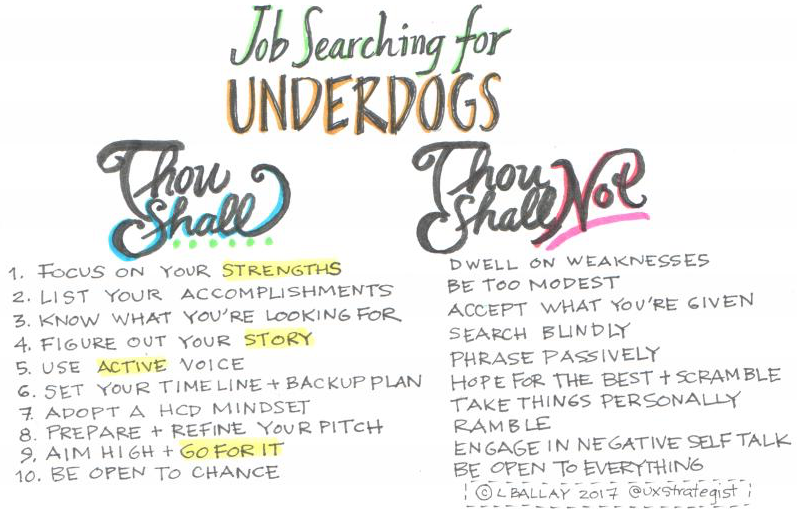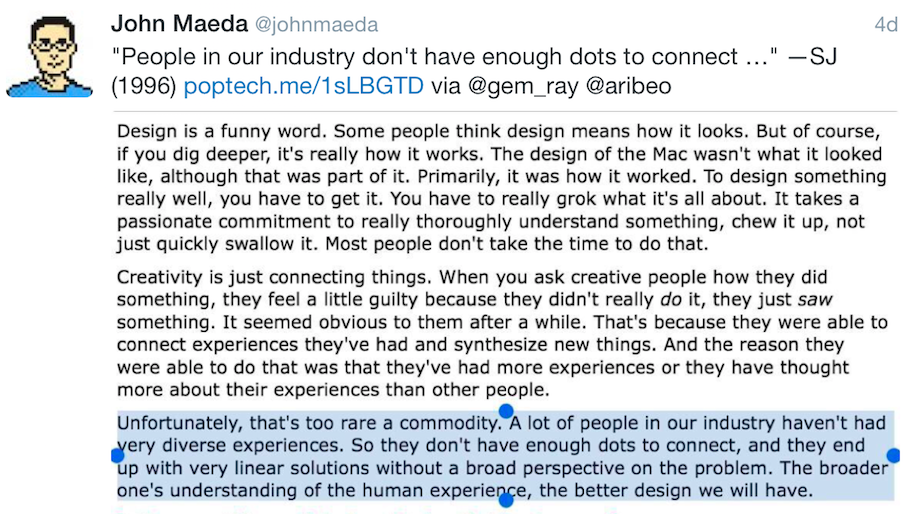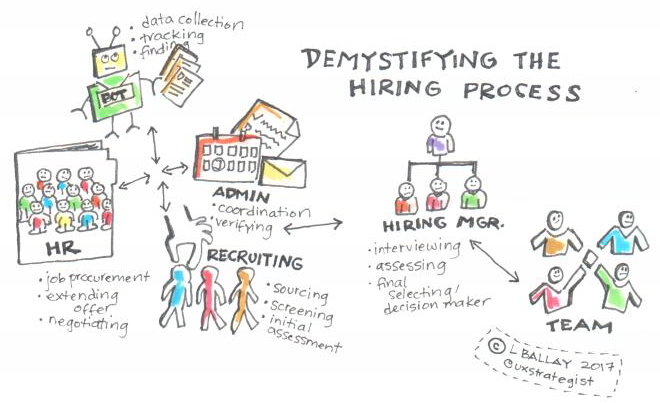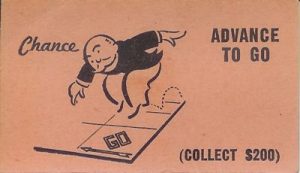I recently gave a talk about job search strategies to students at the Masters of Digital Media. This is an article that summarizes that talk. It was also published on Medium.

First an introduction…
A long, long time ago (at least in tech years) when I was in grad school, I read an article that still speaks to me in dark times. Its title? Mighty is the Mongrel.
I can tell you that up until this point in time, I’d never heard mutts like me celebrated. Quite the opposite. I was a “multidisciplinary” artsy/science-y weirdo who defied all boxes, who vexed all those who wanted to categorize and neatly file me away, who had more ideas than know-how. This made me a fantastic candidate to be on the receiving end of countless job rejections.
So, like others who have encountered the term, “imposter syndrome” was one of those a-ha phrases that suddenly clicked. It tidily summarized everything that I had felt as a lifelong Other in pursuit of a meaningful, yet gainful, employment. And even though I’d miraculously (or so I thought at the time) been admitted to one of the top graduate design programs in the country, I’d already spent a couple of years internalizing that I wasn’t truly worthy or as competitive as my peers because I was told one too many times that I “wasn’t quite what they were looking for.”
The funny thing is, it wasn’t too long before I discovered that many of my ultra-smart, ultra-talented peers felt the same way. Some were just better at putting on the costume than others, but basically we were all bumbling around secretly thinking someone had made a mistake. But little by little, as we progressed through our grad school experience, we began to accept that being an Other, an outsider, could actually be a benefit. That maybe homogeneity and ticking all the right boxes shouldn’t have to be the goal.

Finally, the underdogs would have their day! No longer would I desperately wish that something safe and understood like Accountant would define me. Not quite. Sure, after I graduated with my more “practical” degree, I finally found gainful employment. But my underdog cred persistently blossomed. I experienced those maddening interviews with eyebrow-raising questions, the recruiters that ghost you, the backhanded compliments, the gender salary disparities, the realities of being female and not exactly Caucasian. Even in our Uber Outraged times, I’m not even going to go into all the things I have had going against me, and debate how and why and when this happens. I’ll just say this — as much as diversity and divergent thinking has been discussed and applauded throughout the dotcom, dotbomb, web 2.0, mobile-first times, we still often have a classic case of: the words don’t fit the picture.

(Ahh. As any keen human-centered designer can tell you, observed behaviors don’t always match what is said.)
So, my fellow underdogs, I feel you.
Thanks to design school, I have had pounded into my head Nobel Laureate Herb Simon’s definition of design:
To design is to devise courses of action aimed at changing existing situations into preferred ones.
And I am here to help with just that. And after having countless conversations with newly minted graduates coming out of an inherently multidisciplinary program and university, and hearing their fears, I have compiled a list of recommendations that may help you find more solid footing in the often cruel world of careers. Think of this as one person’s primer on how to circumnavigate and shift the inherent existing contradictions and frustrations of finding a job into one with a (hopefully!) better outcome.
1. Focus on your strengths.
First things first. We’ve got to shut down that inner self-defeating monologue. There’s no better way to do this than to start thinking about what you’re good at. Don’t worry (yet) about linking this to anything as mundane as job responsibilities and all of that corporate speak. Mind map words — particularly verbs — that attract you. Write this all down. Throw in a few that are aspirational but for the most part, keep it real.
Stuck? Enlist friends, colleagues and acquaintances. Make sure it’s a good mix of people. Ask for their help and really listen. Don’t pooh-pooh because it feels wrong to receive and bask in compliments. But also don’t give into the temptation of just asking your good friends. It can be productive to hear about those first impressions. And by the way, I’m also giving you permission to let go of those things that you’re good at but that you don’t enjoy.
2. List your accomplishments
Okay now we’re going to take a look back at what you’ve done, what you’ve made, where you’ve been. If you’re a creative type, collect up your work and lay it all out (it helps if this is actually on a real, physical table). If you’re not, make a timeline to jog your memory. Edit these experiences down to the ones that match your strengths. Start looking for common themes. Now imagine the short blurb that would go next to each accomplishment: what did you do? Why? What was the starting point? The outcome? Why does it stand out to you? Reserve these thoughts for later use.
3. Know what you’re looking for
Here comes the research phase. Your mission is to go find a bunch of job postings that seem like they might be interesting or a match. Don’t anguish about if it’s the porridge Goldilocks chose just yet. Comb through job titles, job descriptions, responsibilities, and qualifications. Read between the lines to see what you can learn about organizational culture, values and working conditions.
Now separate the wheat from the chaff. Scrutinize for fit. Why expend energy, time and feelings on roles and companies that don’t resonate? You’ll make your search more manageable by generating a list of the common keywords, skills, titles, and types of working environments that stand out to you (these keywords will be useful to set up automated job searches later. It will also mean that the talent management/HRMS/ERP bots will find you if you use them). Again, you will want to also cross-reference these with what strengths and complementary experiences you have to offer. Set aside those that don’t bowl you over but seem alright (you may need them for your Plan B in #6).
If some dream jobs seem more senior, that’s okay. Reserve these for your long play. Even though right now you’re fleshing out your initial outline, you can — correction, you should — work on your sequel too. What are the skills that you’ll need to beef up that will help you later on? How do others tend to move up one rung up the ladder? You will always want to think at least one move ahead. If you have your eyes cast upward, you really can’t go wrong with growing these skills: business development, sales, speaking in front of/persuading others (especially those that disagree with you) or anything that lets you oversee a budget.
4. Figure out your story
This one’s a toughie. So first, a little cheerleading rah-rah to get us kickstarted. You’ve got some great talents. Chances are likely that as a category-defying Other, you’re naturally strong at being inquisitive, imaginative, persistent, inventive, and integrative. The problem is that what you and I see as a beautiful jumble of interconnected knowledge often conjures up this image to a potential employer:

Time to add some method to the madness, my friends. Whittle this down to something cohesive, something that draws connections between the points. Because this is what they want to see:

Connecting the dots is going to highly increase your chances of making it to the shortlist. So now deep breath: Synthesize steps 1, 2 and 3. Essentially, your mission is to build a bridge between your capabilities and their needs (here’s some inspiration). Ultimately, you will need variations of your story (the elevator pitch, the long form, the detailed case studies that support it all) to draw from. These stories serve several purposes. First and foremost, they are your north star. They are also a trusty go-to anytime the inevitable, unimaginative statement, “Tell me about yourself” comes up. And finally, stories are memorable in ways that bullet points and facts are not (yup, research says so).
5. Use active voice
This isn’t just grammar, it’s an attitude. Practice saying what you’ve done and to what effect. Repeat after me: I have done things — things aren’t done by me. This is really tough and does not come naturally for those of us who have been conditioned to be modest and not to brag. It will be easier to find and eliminate in your writing, so concentrate your initial passive phrasing crackdown on any written descriptions about your work (CV, cover letter, portfolios, case studies).
But if we are to talk about talking, a good place to start is to recognize that when our nerves are jangled we may draw upon excessive verbal fillers, Valleyspeak, or uptalk. Tame these beasts by practicing your story with friends and invoking active voice.
6. Set your timeline and backup plan(s)
Chunking—trusty friend to memory and cognition—is also a friend to a job seeker’s sanity. Since what I’ve described is not a simply an afternoon’s worth of dashing off a few cover letters and crossing your fingers, breaking it down into smaller goals or chunks is going to make it less daunting. Think of it as the fish ladder for job searching. If you’re a worrywart, or have hard stops like visas or living expenses or student loans weighing upon you, this also has the benefit of allowing you to scaffold your search. For example, you can choose to initially set aside a chunk of time to concentrate solely on only those “dream” jobs, reserving the latter portion of your timeline to expand your search to include the safer, more conservative options. Aka Plan B. The really important part is to focus on the step you are on, and not worry about the parts to come.
7. Adopt a human-centered design mindset
Now to practice a bit of role reversal and check our assumptions. By shifting our perspective and imagining who and what’s happening on the other side, we can better understand the constraints and how to then optimize our job search efforts. For those unfamiliar with the term “human centered design,” here’s how the ISO defines it (minus the technology specific part):
A creative approach….that aims to make systems usable and useful by focusing on the users, designing around their needs and requirements at all stages, and by applying human factors/ergonomics, usability knowledge, and techniques. This approach enhances effectiveness and efficiency, improves human well-being, user satisfaction, accessibility and sustainability; and counteracts possible adverse effects of use on human health, safety and performance.
It might seem like recruiting is a simple, yet mysterious, black box. That behind the curtain it’s operated by one person with superhuman attention and unlimited time. But unless the organization is quite small, there are several players and gates that you need to pass through. Usually it’s a mix of automated systems (the purgatory of resumes/CVs and job applications), recruiter(s), administrative support staff, Human Resources, hiring manager(s), and the the team.

Adopting a human-centered, goal-directed design mindset is critical to understand where you are in this funnel and moreover, what the context, constraints. workflow and goals of the function are. This should then tell you how to optimize your message. The more you really get this, the more likely that you’re going to make it to the next stage. For example, consider that a hiring manager already has a full-time set of responsibilities that does NOT include the time to review potential candidates and interviews. Suddenly it becomes apparent that they are squeezing in these reviews into their day, probably distributing it between other pressing demands along with other distractions vying for their attention. This means that you have a very short window of time to get your message across, so you will need to focus on your information design to minimize cognitive load. Try it with the other stages and functions of the hiring process— it can be kind of enlightening.
8. Prepare and refine your pitch (and portfolio if applicable)
In many ways this is a revisit of #4 but now you’re tweaking your support points with a better understanding of your audience extracted from #7. Essentially you want to have a small set of relevant examples (case studies) you can talk about that demonstrate your capabilities and how you are a good fit for the position. This is where you really refine how you are going to talk about the details depending on who you’re talking to and in what context.
For designer-y types, this means your portfolio should be highly scannable. Usually portfolios are most salient to a hiring managers, so you will want to figure out what information is most relevant and useful to them, then make that information easy to find and understand.
For everyone, I know how vexing it is when it seems like every organization posts that even junior roles must already have X years of experience (where X always equals more than what a typical recent graduate has or some who’s making a career transition will have). There is no shame in not having that yet. Remember that many job ads are simply an aspirational wish list. Don’t talk yourself out of it before you know if those “requirements” are flexible or rigid.
9. Aim high and go for it
Women, this is for you. #8 restated: what seems like the rules may not in fact be the rules. Data seems to point to us not applying unless we feel that we’re 100% compatible for a job. From the HBR article on Why Women Don’t Apply for Jobs Unless They’re 100% Qualified:
People who weren’t applying believed they needed the qualifications not to do the job well, but to be hired in the first place. They thought that the required qualifications were…well, required qualifications. They didn’t see the hiring process as one where advocacy, relationships, or a creative approach to framing one’s expertise could overcome not having the skills and experiences outlined in the job qualifications.
I’m also going to slip in this one for everyone. Please, I beg of you, do not devote all of your time and energy to applying to only online postings. Especially the generic ones that have no human name attached to it. That is a depressing and soul-crushing endeavour. Tap your alumni network. Cultivate in-person connections. Have real conversations. Politely ask for favors and ask for help. Take people to coffee and ask them questions. Plan on paying it forward later.
10. Be open to chance
I hope that curiosity never becomes as hackneyed as “being passionate.” Some places expect you to live and breathe your profession 24/7, the hedgehog triumphing over the fox and all that. I’m sure my fellow underdogs would agree that this is ludicrous. I say show up for the things that you find intriguing even if it doesn’t seem related to your work (or your job search). These forks in the road often lead to interesting places and people.

For us introverted types, this is also a great way to build your network without it feeling slimy and fake. And when I say network, I’m not talking about some old boy’s network — what I mean is that these outlets and the people you meet will sustain you. They will help you continue to connect the dots, and they will support and cheer you on in years to come.
I know all of this isn’t easy. I work on it all the time even still. Sometimes to better effect than others. Wishing you all the best…and perseverance, fortitude and patience.
I’m rooting for you.
